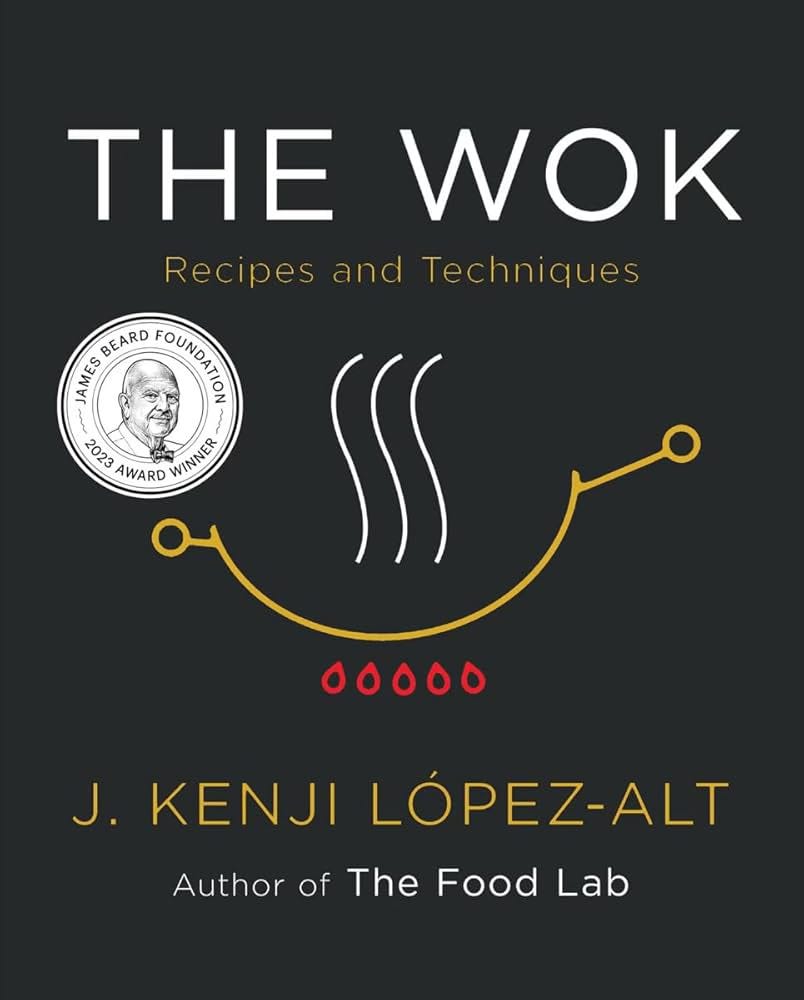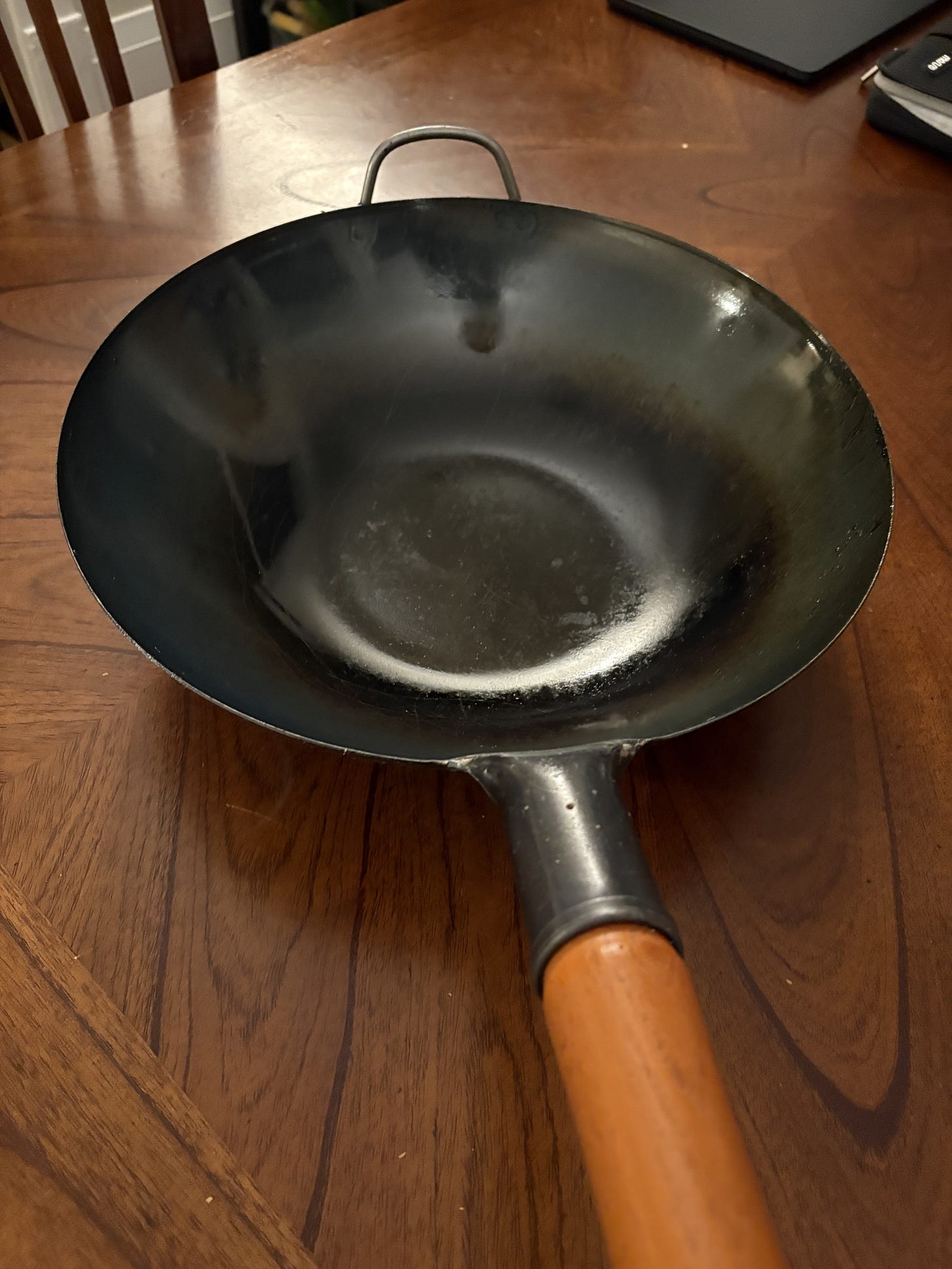My Wok Journey
A brief tale of my journey into wok cooking over the past year.
Late last year, my partner picked up a used copy of The Wok by J. Kenji López-Alt from Facebook marketplace. When they first got it, I was intrigued but didn’t dive in right away. I vaguely knew who Kenji was after seeing him interview the Woks of Life family at Book Larder here in Seattle, but that was the extent of my knowledge. Little did I know I would spend the next year or so reading through the book and building a foundation of knowledge about how to use this amazing pan.
We had acquired a wok along with a smattering of other things from the tenants who rented the apartment before us. It was pretty giant—somewhere around 16 inches—with a loose handle and an unkempt layer of seasoning. I used it a few times to make some so-so fried rice but was honestly intimidated by the pan and had no idea how I was supposed to use it—or the dusty bamboo wok brush that came with it.
A few months later, I found Kenji’s cooking videos on YouTube and was inspired to pick the book up off the shelf and started reading. I was enchanted right from the beginning and started learning some basics of wok cooking. It didn’t take me long to realize a smaller wok would be a better fit, so I picked up a 14-inch carbon steel flat-bottomed pan. Carbon steel is the go to material for woks because it heats evenly, tolerates high heat, and is very responsive to changes in heat. A flat bottom wok is usually the best choice for home cooks since it sits well on a flat heating element or grate. After learning how to season it and the basics of using it, I started making my way through Kenji’s cookbook.
finished reading The Wok this fall. I cooked at least a few recipes from every section, and some of them, like Better-Than-My-Mom’s Chunking Pork (p.95) and San Fransisco-Style Vietnamese American Garlic Noodles (p.330) I’ve made over and over again. I also had fun learning how to deep fry in a wok by making Japanese Katsu (p.465) for the first time. It turns out the wok is an excellent vessel for deep frying, since it has flared sides that keep splatters in and reacts to temperature changes well. Making Moo Shu (Moo Shi) Mushrooms Or Moo Shu Pork (p.104) with Manderin Pancakes (p.106) was a fun challenge - getting the pancakes right is a real skill! The thing I make the most often though is a simple, better than so-so fried rice using Kenji’s detailed instructions and whatever I have in my refrigerator that day.
Cooking anything well can be a challenge, and making meals in a wok is no exception—especially when working with underpowered home burners. Most home gas cooktops top out at around 20k - 40k BTUs, whereas commercial wok burners can be as much as ten times more powerful, at 100k - 200k BTUs! The biggest challenge has been learning the flow of things. Stir-frying goes very quickly, and it’s critical to have your mise en place ready to go before you turn the burner on. Once you get used to the pace and how the wok works on your particular home burner, it just takes practice—just like everything else worth learning in life!
If you haven’t ever used a wok before, I can’t recommend Kenji’s book enough. I’ll share a few other great resources I’ve found this year as well for anyone who might be interested in getting started on their own wok journey. I’m still a novice, but my wok is now my most-used pan in the kitchen, and it has been such a joy learning how to use it!
How to cook in a wok
Check out the resources list below to learn how to use a wok from the experts. This is my abbreviated instructions with commentary:
1. Heat the Wok:
Turn on the heat to high and get the wok hot enough so the thin layer of oil in the pan begins to smoke (the thin layer of oil is laid down at the end of the process in step 5). Getting used to the smoke was the hardest part for me at first, especially when it kept setting off my very sensitive smoke detector! I lessened the issue by setting up good airflow through the kitchen.
2. Add the Oil:
Once the wok is hot, add your oil. Heating the wok first allows the metal to expand slightly, which closes the microscopic pores on the surface. This minimizes sticking and creates a smoother surface for cooking. The hot metal also helps the oil form a thin, even layer due to reduced surface tension. From what I have seen, the biggest mistake people generally make is not getting the oil hot enough, which causes everything to stick to the pan and creates a huge mess!
3. Cook in Batches:
Cook your ingredients without overcrowding the pan. Keep the ingredients moving often, either by tossing the wok or using a spatula. If there’s too much to cook at once, batches are your best friend. For most recipes, I generally:
Start by cooking the protein and larger components of the dish.
Toss everything into a bowl as it finishes.
Add aromatics to the pan and cook them quickly.
Add everything back into the wok.
Finally, add the sauce and finish the dish.
4. Clean the Wok:
Once the dish is finished, move it to a serving plate, then clean the wok with a bamboo brush. I had no idea how to use the brush at first, but I learned that if you tilt the wok away from you and angle the brush similarly, you can run it up and down the surface to easily clean almost anything off in just a few seconds. Occasionally, I’ll use a sponge to get the last bits off, but most of the time, the bamboo brush does the job perfectly. I’m using the natural kind with long thin bamboo bristles.
5. Dry and Re-Oil:
Dry the wok over a hot burner, then re-oil it once all the water has evaporated. This process only takes a minute or two and is easy to do while I’m handling last-minute serving tasks or setting the table. When applying oil, I try to coat every surface of the wok, including the bottom and sides. Just the thinnest layer is all that’s needed to build up a seasoning that will improve over time with continued use.
Resources
Kenji's Youtube Channel - Full of great recipes, for both the wok and other pans.
Wok Skills 101: Stir-Frying Basics - A great article on the basics of stir frying in a wok co-authored by Kenji.
The Woks of Life website - Their accompanying cookbook is also excellent.
Yosukata Carbon Steel 13.5” Wok - This is the wok I own. It’s the perfect size for a home burner and for tossing ingredients comfortably. It has been excellent to use and easy to maintain. The handle is sturdy and well-constructed.



